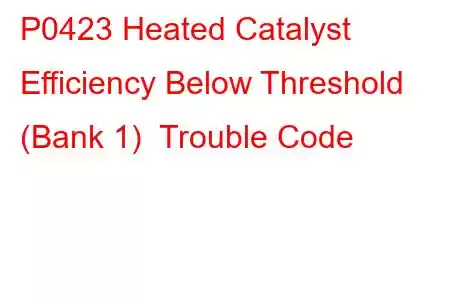P0423 Heated Catalyst Efficiency Below Threshold (Bank 1)
OBD-II Trouble Code Technical Description
Heated Catalyst Efficiency Below Threshold (Bank 1)
What does that mean?
This diagnostic trouble code (DTC) is a generic powertrain code, which means that it applies to OBD-II equipped vehicles (Dodge, Ram, Ford, GMC, Chevrolet, VW, Audi, Toyota, etc.). Although generic, the specific repair steps may vary depending on make/model.
If your OBD-II equipped vehicle has stored a code P0423, it means that the powertrain control module (PCM) has detected a problem with the efficiency of the catalytic converter for engine bank one. Bank 1 indicates that the malfunction has occurred in the bank of the engine which contains the number one cylinder.
The catalytic converter is used to reduce exhaust emissions produced by diesel and gasoline fueled engines. Its key component is a filtration block, composed of ceramic fibers interwoven with platinum and other precious metals, enclosed in an inline steel housing and positioned in the exhaust system. Nitrogen oxide (N2O) particles, carbon monoxide, and unburned hydrocarbons are reduced to harmless ions of nitrogen, oxygen, carbon dioxide, and water inside the catalytic converter.
Emission reduction is accomplished using the dense filtration block combined with the extreme heat of the engine exhaust. Temperatures inside the catalytic converter must reach at least 800-degrees Fahrenheit to reduce emission levels effectively. Upstream and downstream oxygen (O2) sensor signals are used by the PCM to monitor catalytic converter efficiency.
Exhaust gases are pushed through the manifold, into the exhaust pipe, over the upstream O2 sensor, and through the catalytic converter. After they pass through the catalytic converter, they flow across the downstream O2 sensor.
If the upstream and downstream O2 sensor signals reflect too similar an exhaust oxygen concentration, a code P0423 will be stored and a malfunction indicator lamp (MIL) may be illuminated.
Other bank 1 catalyst efficiency trouble codes include P0420, P0421, P0422, P0424, P0425, P0426, P0427, P0428, and P0429.
Code Severity & Symptoms
A stored code P0423 could indicate that the fuel delivery system is not functioning properly. It should be treated as severe.
Symptoms of this code may include:
Decreased fuel efficiency A lack of general engine performance Other related diagnostic trouble codes MIL (malfunction indicator lamp) illuminationCauses
Potential causes for this code to set are:
Bad catalytic converter Ignition misfire/s A faulty mass air flow or manifold air pressure sensor Defective O2 sensor/s Burnt, broken, or disconnected wiring and/or connectors Pre-cat engine exhaust leakDiagnostic and Repair Procedures
A diagnostic scanner, digital volt ohmmeter (DVOM), and a reliable vehicle information source (such as All Data DIY) will be required for me to diagnose a code P0423.
Any misfire codes, throttle position sensor codes, manifold air pressure codes, or mass air flow sensor codes should be addressed before attempting to diagnose a stored code P0423. The engine must also be running efficiently before diagnosing a P0423.
I would usually begin with a visual inspection of system wiring harnesses and connectors. I would focus on harnesses that are routed near hot exhaust pipes and manifolds, as well as those that are routed near sharp edged objects like exhaust shields.
I would continue by connecting the scanner to the vehicle diagnostic port and retrieving all trouble codes and freeze frame data. I like to write this information down as it may be helpful if this proves to be an intermittent code. Intermittent codes can be much harder to diagnose.
Next, I’d clear the codes and test-drive the vehicle.
Should the P0423 be immediately reset
Read: 47


